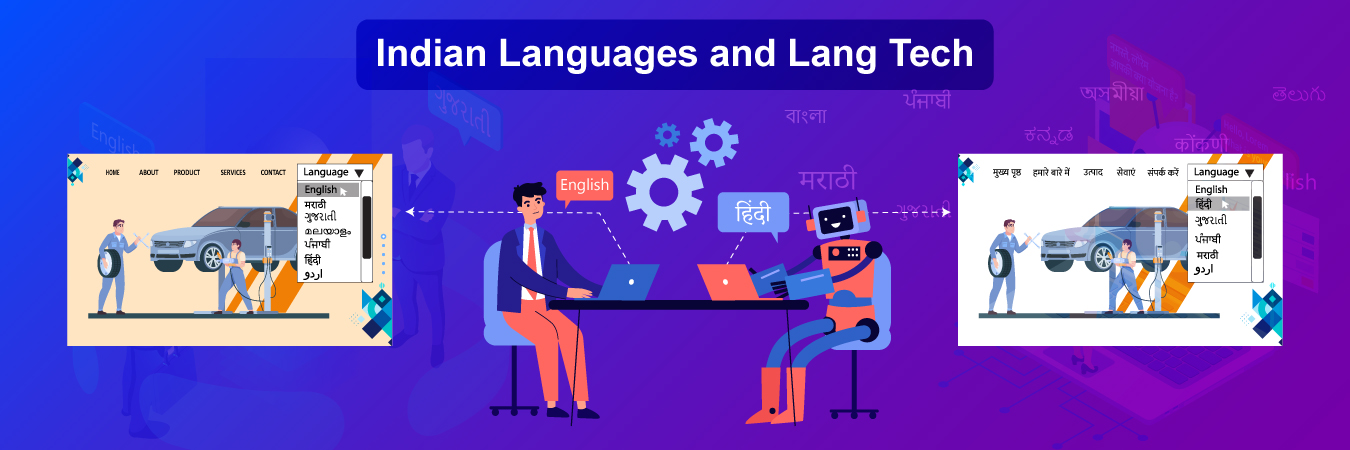
Indian Languages and LangTech
As a highly diverse country, India is home to hundreds of languages and thousands of dialects. Yes, the Indian constitution recognizes 22 languages. But if you delve deep into India’s language realm, you’d be nothing less than astonished to discover the country’s linguistic heritage!
While we are proud to have as many languages, it is unfortunate that Indian languages remained ignored all along. Languages like Japanese, Chinese, Spanish, French, etc., gained importance worldwide. They have had major players investing in localizing products in these languages. But comparatively Indian languages couldn’t really make it big across the global horizon.
However, the good thing is, things are gradually changing. With an increased number of regional internet users (over 600 million), companies worldwide are realizing the grandeur of India as a potential market. Technology is quickly making its way across the Indian linguistic horizon. Let’s look at some aspects associated with Indian languages and language technology.
Why is Lang Tech a Challenge in the Indian Linguistic Context?
While the Indian market has always grabbed the eyeballs of global enterprises, localization in the Indian context is a very broad area. The number of languages and the country’s cultural diversity make things challenging. Let’s look at some challenges that companies usually face.
Number of Languages and their Limited Scope
Almost every state in India speaks a different language. But the scope of languages is primarily confined to their state. For instance, Kannada is spoken predominantly in Karnataka with some speakers in border areas of the neighboring states like Maharashtra, Andhra Pradesh, Kerala, and Tamil Nadu.
Similarly, Marathi also has a limited scope. It is primarily spoken in Maharashtra and to some extent in Gujarat, northwest Karnataka, parts of MP, etc. Thus, if a company decides to target Marathi users, with all its investment, it will only be able to target Maharashtra. The case with Gujarati, Marwari, etc. isn’t different.
Thus, the company will have to invest in every target language separately. It will have to create a unique strategy around it to ensure regional penetration. While this might not be a problem for the larger players, it certainly is for the mid-sized and the smaller ones that don’t have the wherewithal to invest as much.
Add to it regional linguistic variations. Marathi, for instance, is spoken differently in various parts of the state. For example, the Marathi spoken across the state’s coastal belt is distinct from that of districts near MP, Chhattisgarh, Telangana, and Andhra Pradesh. Dealing with every variation is a different ball game.
Cultural Differences
Localization isn’t as straightforward or merely a translation. It is a comprehensive strategy that involves aligning your content and conversation to suit a particular country’s culture as well. Thus, with India, which is known for its cultural diversity, localization becomes even more challenging. What applies in the northern context might not necessarily go well with the country’s eastern frontier.
Now, these aspects contribute to the complexities of language technology. For instance, let’s take the example of a virtual assistant. While localizing conversations for it, you would have challenges of regional variations.
It means, which variation do you consider correct? It matters because people from various regions using it will have their unique accents, words, and tone of communicating with the virtual assistant.
In situations like these, if the virtual assistant does not understand a hyperlocal word, it may fail to respond and spoil the user experience. But if companies would go on to address every regional variation, imagine the kind of time and investment the entire project will require to complete!
But many companies are gradually foraying into the Indian regional linguistic territories. One of the best examples is Siri with whom you can communicate in various languages like Bengali, Marathi, Kannada, Telugu, Hindi, Gujarati, etc.
Technical Challenges
Another significant challenge with lang tech is the local language font. Almost every Indian language has its unique script. But many of them do not have generic fonts available, which could enable users to type. Most are proprietary and require the user to have them specifically to be able to type or read a particular language script.
Besides, the fonts might not necessarily have all characters that a particular language uses accurately. These nuances lead to inaccuracies. Thus, the need for generic, readily available, open-source, and accurate fonts is the need to help language technology flourish in the Indian context.
Unleash the Power of Lang Tech with FidelSoftech
With expertise in over 100+ Indian and foreign languages and extensive technical expertise in the lang tech domain, FidelSoftech can help you with your localization endeavors. We are a one-stop point for efficient and accurate localization in multiple languages for various business domains.
Our subject matters, linguists, translators, and technology experts work closely to help you overcome various technical and strategic challenges in localization. Thus, we help you unlock the potential of localization in the Indian context and catalyze business outreach within the country’s regional markets.
For details, write to us at sales@fidelsoftech.com.
Ref. No – FB12221040
Related Blogs
What is the Role of SAP Localization?
SAP, which stands for System Applications and Products is an ERP software solution, helps companies manage operations and customer…
Unlocking Growth: Globalization Marketing Advantages
At some point in time, every organization looks to expand its horizon and venture into markets never explored before. However, every market is...
Advantages and Disadvantages of Internationalization
These days, most businesses that intend to go global know they will have to align their offerings and communication to suit the target audience’s...



